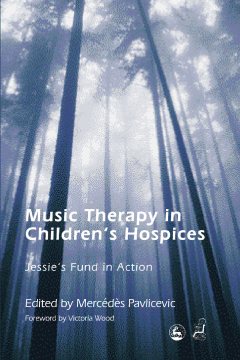
Additional Information
Book Details
Abstract
The use of music therapy in children's hospices has burgeoned since its introduction by Jessie's Fund in the mid-90s. This moving and extremely helpful text brings together the experiences of eleven music therapists working with children who are in the final stages of life-limiting illness.
The contributors adapt music therapy to hospice environments and explore key concerns for all practitioners, including how to empower ill children and their families, how to help bereaved siblings, and how the therapists themselves find support. The book celebrates the communities created through an inclusive music therapy practice with children, their families and hospice staff.
This text is essential reading for all music therapists working in palliative care and for health care professionals considering introducing music as a therapy.
This book provides a valuable contribution to the expanding area surrounding music therapy and palliative care with a particular focus on children. Part of this contribution lies in the way this book was created, that is, how the idea of "Jessie's Fund" first came about. This book celebrates the "birth" of music therapy services for children in hospices in the United Kingdom, or as described by the Editor in the opening of the introduction - "a celebration of Jessie's fund in action" (p. 18).
Nordic Journal of Music Therapy
Music was in every cell of Jessie George's small body. Her family probably hoped it would crowd out the cancer there as well, but that was not to be. Inspired by Jessies's Fund, created to support music therapy in children's hospices and other medical settings, these 11 essays by therapists, families and patients, shows music therapy, interwoven into the supportive and loving atmosphere of a well-run children's hospice, contributes to the lives of patients and aids family members in surprising ways. The essays also include practical ways to start music therapy programs in medical settings with child patients, and ways to extend the benefits into the community. Jessie, no doubt, would approve.
Book News
Whether music therapy or jamming, this book should be recommended as a remarkable story of what can be achieved from personal experience and commitment, and of the unquestionable power of music in the children's hospice setting.
Mortality
This would be a valuable resource for those music therapists working in paediatric palliative care. It can be read a s a whole or in parts as the testimony of music therapists who have been privileged to accompany clients on their journey through life-limiting, life threatening illnesses, and have observed the unique value of creative music making in this setting.
Australian Journal of Music Therapy
Table of Contents
| Section Title | Page | Action | Price |
|---|---|---|---|
| Prelims [ Inter-Church Organization for Development | Cooperation Statement | Acknowledgements | Series Editors’ Foreword | Author’s Preface | |||
| 1 Livelihoods Perspectives: A Brief History | |||
| Livelihoods Thinking | |||
| Sustainable Rural Livelihoods | |||
| Keywords | |||
| Core Questions | |||
| 2 Livelihoods, Poverty and Wellbeing | |||
| Livelihood Outcomes: Conceptual Foundations | |||
| Measuring Livelihood Outcomes | |||
| Evaluating Inequality | |||
| Multidimensional Metrics and Indices | |||
| Whose Indicators Count? Participatory and Ethnographic Approaches | |||
| Poverty Dynamics and Livelihood Change | |||
| Rights, Empowerment and Inequality | |||
| Conclusion | |||
| 3 Livelihoods Frameworks and Beyond | |||
| Livelihood Contexts and Strategies | |||
| Livelihood Assets, Resources and Capitals | |||
| Livelihood Change | |||
| Politics and Power | |||
| What’s in a Framework? | |||
| Conclusion | |||
| 4 Access and Control: Institutions, Organizations and Policy Processes | |||
| Institutions and Organizations | |||
| Understanding Access and Exclusion | |||
| Institutions, Practice and Agency | |||
| Difference, Recognition and Voice | |||
| Policy Processes | |||
| Unpacking the Black Box | |||
| 5 Livelihoods, the Environment and Sustainability | |||
| People and the Environment: A Dynamic Relationship | |||
| Resource Scarcity: Beyond Malthus | |||
| Non-Equilibrium Ecologies | |||
| Sustainability as Adaptive Practice | |||
| Livelihoods and Lifestyles | |||
| A Political Ecology of Sustainability | |||
| Sustainability Reframed: Politics and Negotiation | |||
| 6 Livelihoods and Political Economy | |||
| Unity of the Diverse | |||
| Class, Livelihoods and Agrarian Dynamics | |||
| States, Markets and Citizens | |||
| Conclusion | |||
| 7 Asking the Right Questions: An Extended Livelihoods Approach | |||
| Political Economy and Rural Livelihood Analysis: Six Cases | |||
| Emerging Themes | |||
| Conclusion | |||
| 8 Methods for Livelihoods Analysis | |||
| Mixed Methods: Beyond Disciplinary Silos | |||
| Operational Approaches to Livelihoods Assessment | |||
| Towards a Political Economy Analysis of Livelihoods | |||
| Challenging Biases | |||
| Conclusion | |||
| 9 Bringing Politics Back In: New Challenges for Livelihoods Perspectives | |||
| Politics of Interests | |||
| Politics of Individuals | |||
| Politics of Knowledge | |||
| Politics of Ecology | |||
| A New Politics of Livelihoods | |||
| Back Matter [References | Index] |
